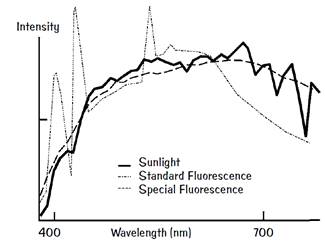
Fluorescent Lights
 المؤلف:
Franklin Potter and Christopher Jargodzki
المؤلف:
Franklin Potter and Christopher Jargodzki
 المصدر:
Mad about Modern Physics
المصدر:
Mad about Modern Physics
 الجزء والصفحة:
p 66
الجزء والصفحة:
p 66
 20-10-2016
20-10-2016
 603
603
Fluorescent Lights
The gas plasma inside a fluorescent tube emits mostly ultraviolet radiation and very little visible radiation. Electrons are captured by the ions and jump down to lower energies, emitting a characteristic UV photon for each fluorescence jump. Why are fluorescent tubes so much more efficient in producing visible light than incandescent lamps?
Why can the light from some fluorescent lights be dangerous to your health? Could it be that they emit some UV? Are there types of fluorescent tubes that are better for human working environments? Are they better because they do not emit in the UV?
Answer
Today, artificial illumination requires more than 25 percent of the electricity generated worldwide. There are two trends in “energy saving” technologies. The first trend is using improved lamps, such as fluorescent, mercury, sodium, metal halide, and halogen lamps. The second trend is improving the electronic circuit design for such lamps.
Although fluorescent lights are four to six times more efficient than incandescent lamps, there now exist many other types of light sources that are even more efficient. For the fluorescent lamp, its efficient production of the UV is extended into the visible by a powder coating inside the tube. This powder absorbs the UV light and fluoresces in the visible. Very little heating of the fluorescent lamp occurs, so the efficiency occurs before the production of the visible light, with very little electrical energy being converted into thermal energy. The conversion process in the powder makes the tube useful for room lighting.
So why is the incandescent lamp so inefficient, converting only about 4 percent to 12 percent of the electrical energy to visible light? The incandescent lamp is simply a resistor whose filament temperature rises until it gets rid of thermal energy at the same rate that thermal energy is being generated in the filament. In a standard 100- watt, 120-volt bulb, the filament temperature is roughly 2550°C, about 4600°F, so that the thermal radiation from the filament includes a significant amount of visible light.
The output is 17.5 lumens per watt, compared to a maximum of 240 lumens per watt if all the energy could be converted to visible light. The reason for this poor efficiency is the fact that tungsten filaments radiate mostly infrared radiation at any temperature that they can withstand. An ideal thermal radiator produces visible light most efficiently at temperatures of about 6300°C (about 6600 K or 11,500°F). Even at this high temperature, a lot of the radiation is either infrared or ultraviolet, and the theoretical luminous efficiency is 95 lumens per watt.
Most fluorescent lights predominantly emit light in the visible part of the spectrum and they do emit some UV light, but only in a narrow range of the UV spectrum. Unfortunately, their UV emission range does not overlap the two small ranges of UV light needed by humans for the best functioning of certain internal organs, which receive some of the UV light that passes through the skin, as well as vitamin D production from 7-dehydrocholesterol in the skin.

Special fluorescent lights more benevolent to human needs are available and mimic sunlight to produce a UV spectrum better matching the needs of these internal organs. Indeed, the lack of the required UV parts of the ambient light spectrum can lead to certain illnesses. Of course, the lack of vitamin D production in the skin can lead to rickets and other problems associated with the calcium and inorganic phosphate metabolism. Eskimos and other indigenous peoples obtain plenty of vitamin D from the fish oils in their diets.
 الاكثر قراءة في طرائف الفيزياء
الاكثر قراءة في طرائف الفيزياء
 اخر الاخبار
اخر الاخبار
اخبار العتبة العباسية المقدسة


